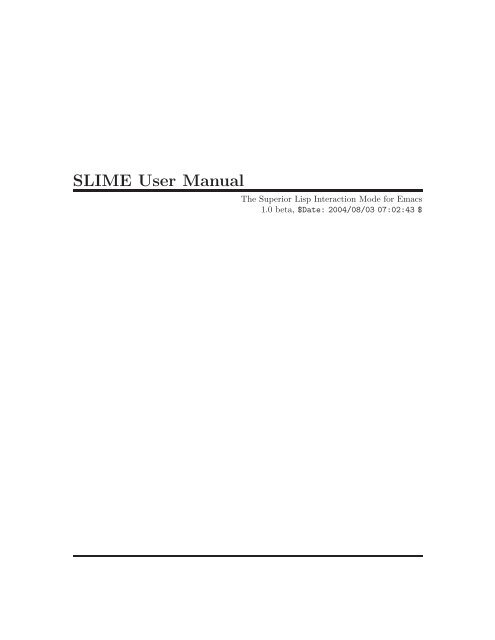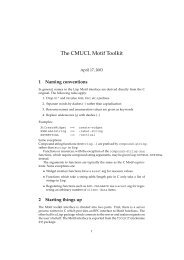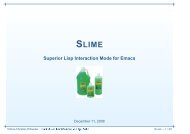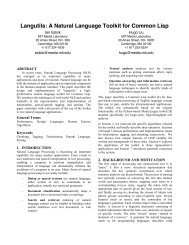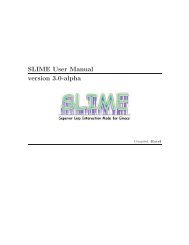SLIME User Manual - Common Lisp.net
SLIME User Manual - Common Lisp.net
SLIME User Manual - Common Lisp.net
- No tags were found...
You also want an ePaper? Increase the reach of your titles
YUMPU automatically turns print PDFs into web optimized ePapers that Google loves.
<strong>SLIME</strong> <strong>User</strong> <strong>Manual</strong>The Superior <strong>Lisp</strong> Interaction Mode for Emacs1.0 beta, $Date: 2004/08/03 07:02:43 $
iTable of Contents1 Introduction . . . . . . . . . . . . . . . . . . . . . . . . . . . . . . . 12 Getting started . . . . . . . . . . . . . . . . . . . . . . . . . . . . 22.1 Supported Platforms . . . . . . . . . . . . . . . . . . . . . . . . . . . . . . . . . . . . 22.2 Downloading <strong>SLIME</strong> . . . . . . . . . . . . . . . . . . . . . . . . . . . . . . . . . . . . 22.2.1 Downloading from CVS . . . . . . . . . . . . . . . . . . . . . . . . . 22.2.2 CVS incantations . . . . . . . . . . . . . . . . . . . . . . . . . . . . . . . 22.3 Installation . . . . . . . . . . . . . . . . . . . . . . . . . . . . . . . . . . . . . . . . . . . . . 32.4 Running <strong>SLIME</strong> . . . . . . . . . . . . . . . . . . . . . . . . . . . . . . . . . . . . . . . . 33 slime-mode . . . . . . . . . . . . . . . . . . . . . . . . . . . . . . . . . 43.1 <strong>User</strong>-interface conventions. . . . . . . . . . . . . . . . . . . . . . . . . . . . . . . . 43.1.1 Temporary buffers . . . . . . . . . . . . . . . . . . . . . . . . . . . . . . 43.1.2 Key bindings . . . . . . . . . . . . . . . . . . . . . . . . . . . . . . . . . . . 43.1.3 *inferior-lisp* buffer . . . . . . . . . . . . . . . . . . . . . . . . 43.2 Commands . . . . . . . . . . . . . . . . . . . . . . . . . . . . . . . . . . . . . . . . . . . . . 53.2.1 Compilation commands . . . . . . . . . . . . . . . . . . . . . . . . . 53.2.2 Finding definitions (“Meta-Point”). . . . . . . . . . . . . . . 53.2.3 <strong>Lisp</strong> Evaluation. . . . . . . . . . . . . . . . . . . . . . . . . . . . . . . . . 63.2.4 Documentation . . . . . . . . . . . . . . . . . . . . . . . . . . . . . . . . . 63.2.5 Programming Helpers . . . . . . . . . . . . . . . . . . . . . . . . . . . 73.2.6 Abort/Recovery . . . . . . . . . . . . . . . . . . . . . . . . . . . . . . . . 73.2.7 Cross-reference . . . . . . . . . . . . . . . . . . . . . . . . . . . . . . . . . 83.2.8 Inspector. . . . . . . . . . . . . . . . . . . . . . . . . . . . . . . . . . . . . . . 83.2.9 Profiling . . . . . . . . . . . . . . . . . . . . . . . . . . . . . . . . . . . . . . . 93.3 Semantic indentation . . . . . . . . . . . . . . . . . . . . . . . . . . . . . . . . . . . . 93.4 Reader conditional fontification. . . . . . . . . . . . . . . . . . . . . . . . . . 104 REPL: the “top level” . . . . . . . . . . . . . . . . . . . . 114.1 REPL commands . . . . . . . . . . . . . . . . . . . . . . . . . . . . . . . . . . . . . . 114.2 Input navigation . . . . . . . . . . . . . . . . . . . . . . . . . . . . . . . . . . . . . . . 114.3 Shortcuts . . . . . . . . . . . . . . . . . . . . . . . . . . . . . . . . . . . . . . . . . . . . . . 125 SLDB: the <strong>SLIME</strong> debugger . . . . . . . . . . . . . . . 135.1 Examining frames . . . . . . . . . . . . . . . . . . . . . . . . . . . . . . . . . . . . . . 135.2 Invoking restarts . . . . . . . . . . . . . . . . . . . . . . . . . . . . . . . . . . . . . . . 135.3 Navigating between frames . . . . . . . . . . . . . . . . . . . . . . . . . . . . . . 135.4 Miscellaneous Commands . . . . . . . . . . . . . . . . . . . . . . . . . . . . . . . 14
Chapter 1: Introduction 11 Introductionslime is the “Superior <strong>Lisp</strong> Interaction Mode for Emacs.”slime extends Emacs with new support interactive programming in <strong>Common</strong> <strong>Lisp</strong>. Thefeatures are centred around slime-mode, an Emacs minor-mode that compliments the standardlisp-mode. While lisp-mode supports editing <strong>Lisp</strong> source files, slime-mode addssupport for interacting with a running <strong>Common</strong> <strong>Lisp</strong> process for compilation, debugging,documentation lookup, and so on.The slime-mode programming environment follows the example of Emacs’s native Emacs<strong>Lisp</strong> environment. We have also included good ideas from similar systems (such as ilisp)and some new ideas of our own.slime is constructed from two parts: a user-interface written in Emacs <strong>Lisp</strong>, and asupporting server program written in <strong>Common</strong> <strong>Lisp</strong>. The two sides are connected togetherwith a socket and communicate using an rpc-like protocol.The <strong>Lisp</strong> server is primarily written in portable <strong>Common</strong> <strong>Lisp</strong>. The requiredimplementation-specific functionality is specified by a well-defined interface andimplemented separately for each <strong>Lisp</strong> implementation. This makes slime readily portable.
Chapter 2: Getting started 22 Getting startedThis chapter tells you how to get slime up and running.2.1 Supported Platformsslime supports a wide range of operating systems and <strong>Lisp</strong> implementations. slime runson Unix systems, Mac OSX, and Microsoft Windows. GNU Emacs versions 20 and 21 andXEmacs version 21 are supported.The supported <strong>Lisp</strong> implementations, roughly ordered from the best-supported, are:• CMU <strong>Common</strong> <strong>Lisp</strong> (cmucl)• Steel Bank <strong>Common</strong> <strong>Lisp</strong> (sbcl)• OpenMCL• <strong>Lisp</strong>Works• Allegro <strong>Common</strong> <strong>Lisp</strong> (acl)• clisp• Armed Bear <strong>Common</strong> <strong>Lisp</strong> (abcl)Most features work uniformly across implementations, but some are prone to variation.These include the precision of placing compiler-note annotations, xref support, and fancydebugger commands (like “restart frame”).2.2 Downloading <strong>SLIME</strong>You can choose between using a released version of slime or accessing our cvs repositorydirectly. You can download the latest released version from our website:http://www.common-lisp.<strong>net</strong>/project/slime/We recommend that users who participate in the slime-devel mailing list use the cvsversion of the code.2.2.1 Downloading from CVSslime is available from the cvs repository on ‘common-lisp.<strong>net</strong>’. You have the option touse either the very latest code or the tagged FAIRLY-STABLE snapshot.The latest version tends to have more features and fewer bugs than the FAIRLY-STABLEversion, but it can be unstable during times of major surgery. As a rule-of-thumb recommendationwe suggest that if you follow the slime-devel mailing list then you’re betteroff with the latest version (we’ll send a note when it’s undergoing major hacking). If youdon’t follow the mailing list you won’t know the status of the latest code, so trackingFAIRLY-STABLE or using a released version is the safe option.If you checkout from cvs then remember to cvs update occasionally. Improvements arecontinually being committed, and the FAIRLY-STABLE tag is moved forward from time totime (about once per month).
Chapter 2: Getting started 32.2.2 CVS incantationsTo download slime you first configure your CVSROOT and login to the repository.export CVSROOT=:pserver:anonymous@common-lisp.<strong>net</strong>:/project/slime/cvsrootcvs login(The password is anonymous)The latest version can then be checked out with:cvs checkout slimeOr the FAIRLY-STABLE version can be checked out with:cvs checkout -rFAIRLY-STABLE slimeIf you want to find out what’s new since the version you’re currently running, you candiff the local ‘ChangeLog’ against the repository version:cvs diff -rHEAD ChangeLog2.3 Installation# or: -rFAIRLY-STABLEOn Unix-like systems, installation just requires a few lines in your ‘~/.emacs’:(setq inferior-lisp-program "the path to your <strong>Lisp</strong> system")(add-to-list ’load-path "the path of your ‘slime’ directory")(require ’slime)(slime-setup)The snippet above also appears in the ‘README’ file. You can copy&paste it from there,but remember to fill in the appropriate path.2.4 Running <strong>SLIME</strong>slime is started with the Emacs command M-x slime. This uses the inferior-lisp packageto start a <strong>Lisp</strong> process, loads and starts the <strong>Lisp</strong>-side server (known as “Swank”), andestablishes a socket connection between Emacs and <strong>Lisp</strong>. Finally a repl buffer is createdwhere you can enter <strong>Lisp</strong> expressions for evaluation.At this point slime is up and running and you can start exploring.
Chapter 3: slime-mode 43 slime-modeslime’s commands are provided via slime-mode, a minor-mode used in conjunction withEmacs’s lisp-mode. This chapter describes the slime-mode and its relatives.3.1 <strong>User</strong>-interface conventionsTo use slime comfortably it is important to understand a few “global” user-interface characteristics.The most important principles are described in this section.3.1.1 Temporary buffersSome slime commands create temporary buffers to display their results. Although thesebuffers usually have their own special-purpose major-modes, certain conventions are observedthroughout.Temporary buffers can be dismissed by pressing q. This kills the buffer and restores thewindow configuration as it was before the buffer was displayed. Temporary buffers can alsobe killed with the usual commands like kill-buffer, in which case the previous windowconfiguration won’t be restored.Pressing RET is supposed to “do the most obvious useful thing.” For instance, in anapropos buffer this prints a full description of the symbol at point, and in an xref bufferit displays the source code for the reference at point. This convention is inherited fromEmacs’s own buffers for apropos listings, compilation results, etc.Temporary buffers containing <strong>Lisp</strong> symbols use slime-mode in addition to any specialmode of their own. This makes the usual slime commands available for describing symbols,looking up function definitions, and so on.3.1.2 Key bindingsIn general we try to make our key bindings fit with the overall Emacs style. We also havethe following somewhat unusual convention of our own: when entering a three-key sequence,the final key can be pressed either with control or unmodified. For example, the slimedescribe-symbolcommand is bound to C-c C-d d, but it also works to type C-c C-d C-d.We’re simply binding both key sequences because some people like to hold control for allthree keys and others don’t, and with the two-key prefix we’re not afraid of running out ofkeys.3.1.3 *inferior-lisp* bufferslime internally uses the inferior-lisp package to start <strong>Lisp</strong> processes. This has a fewuser-visible consequences, some good and some not-so-terribly. To avoid confusion it isuseful to understand the interactions.The buffer *inferior-lisp* contains the <strong>Lisp</strong> process’s own top-level. This directaccess to <strong>Lisp</strong> is useful for troubleshooting, and some degree of slime integration is available
Chapter 3: slime-mode 5using the inferior-slime-mode. However, in normal use we recommend using the fullyintegratedslime repl and ignoring the *inferior-lisp* buffer.An unfortunate property of inferior-lisp is it inserts some commands of its owndirectly into the lisp-mode keymap, such that they aren’t easily disabled. This makes <strong>Lisp</strong>source buffers slightly schizophrenic, having both slime and inferior-lisp commandsbound to keys and operating independently.slime overrides most key bindings, so in practice you are unlikely to accidentally usean inferior-lisp command. If you do find a command that pops up the *inferiorlisp*buffer, that command doesn’t belong to slime, and you should probably lookup ourequivalent.3.2 Commands3.2.1 Compilation commandsslime has fancy commands for compiling functions, files, and packages. The fancy part isthat notes and warnings offered by the <strong>Lisp</strong> compiler are intercepted and annotated directlyonto the corresponding expressions in the <strong>Lisp</strong> source buffer. (Give it a try to see what thismeans.)C-c C-kC-c M-kC-c C-cslime-compile-and-load-fileCompile and load the current buffer’s source file.slime-compile-fileCompile (but don’t load) the current buffer’s source file.slime-compile-defunCompile the top-level form at point.The annotations are indicated as underlining on source forms. The compiler messageassociated with an annotation can be read either by placing the mouse over the text or withthe selection commands below.M-nM-pC-c M-cslime-next-note, slime-previous-noteThese commands move the point between compiler notes and display the newnote.slime-remove-notesRemove all annotations from the buffer.3.2.2 Finding definitions (“Meta-Point”).The familiar M-. command is provided. For generic functions this command finds all methods,and with some systems it does other fancy things (like tracing structure accessors totheir DEFSTRUCT definition).M-.slime-edit-definitionGo to the definition of the symbol at point.
Chapter 3: slime-mode 6M-, slime-pop-find-definition-stack Go back from a definition found with M-.. This gives multi-level backtracking when M-. has been used several times.3.2.3 <strong>Lisp</strong> EvaluationThese commands each evaluate a <strong>Lisp</strong> expression in a different way. By default they showtheir results in a message, but a prefix argument causes the results to be printed in therepl instead.C-M-xC-c C-eC-c C-pC-c C-rC-c :slime-eval-defunEvaluate top-level form.slime-eval-last-expressionEvaluate the expression before point.slime-pprint-eval-last-expressionEvaluate the expression before point and pretty-print the result.slime-eval-regionEvaluate the region.slime-interactive-evalEvaluate an expression read from the minibuffer.M-x slime-scratchCreate a ‘*slime-scratch*’ buffer. In this buffer you can enter <strong>Lisp</strong> expressionsand evaluate them with C-j, like in Emacs’s ‘*scratch*’ buffer.3.2.4 Documentationslime’s online documentation commands follow the example of Emacs <strong>Lisp</strong>. The commandsall share the common prefix C-c C-d and allow the final key to be modified or unmodified(See Section 3.1.2 [Key bindings], page 4.)C-c C-d dC-c C-d aC-c C-d zC-c C-d pslime-describe-symbolDescribe the symbol at point.slime-aproposApropos search. Search <strong>Lisp</strong> symbol names for a substring match and presenttheir documentation strings. By default the external symbols of all packagesare searched. With a prefix argument you can choose a specific package andwhether to include unexported symbols.slime-apropos-allLike slime-apropos but also includes internal symbols by default.slime-apropos-packageShow apropos results of all symbols in a package. This command is for browsinga package at a high-level. With package-name completion it also serves as arudimentary Smalltalk-ish image-browser.
Chapter 3: slime-mode 7C-c C-d hC-c C-d ~slime-hyperspec-lookupLookup the symbol at point in the <strong>Common</strong> <strong>Lisp</strong> Hyperspec. This uses thefamiliar ‘hyperspec.el’ to show the appropriate section in a web browser. TheHyperspec is found either on the Web or in common-lisp-hyperspec-root,and the browser is selected by browse-url-browser-function.common-lisp-hyperspec-formatLookup a format character in the <strong>Common</strong> <strong>Lisp</strong> Hyperspec.3.2.5 Programming HelpersM-TABC-c M-iSPCC-c C-sC-c C-mC-c M-mC-c C-tC-c M-dslime-complete-symbolComplete the symbol at point. Note that three styles of completion are availablein slime, and the default differs from normal Emacs completion. SeeSection 7.1 [Emacs-side customization], page 17.slime-fuzzy-complete-symbolPresents a list of likely completions to choose from for an abbreviation atpoint. This is a third completion method and it is very different from the moretraditional completion to which slime-complete-symbol defaults. It attemptsto complete a symbol all at once, instead of in pieces. For example, “mvb”will find “multiple-value-bind” and “norm-df” will find “least-positivenormalized-double-float”.This can also be selected as the method of completionused for slime-complete-symbol.slime-spaceThe space key inserts a space and also looks up and displays the argument listfor the function at point, if there is one.slime-insert-arglistLooks up and inserts into the current buffer the argument list for the functionat point, if there is one.slime-macroexpand-1Macroexpand the expression at point once.slime-macroexpand-allFully macroexpand the expression at point.slime-toggle-trace-fdefinitionToggle tracing of the function at point.slime-disassemble-symbolDisassemble the function definition of the symbol at point.3.2.6 Abort/RecoveryC-c C-gC-c ~slime-interruptInterrupt <strong>Lisp</strong> (send SIGINT). In XEmacs use C-c C-b.slime-sync-package-and-default-directorySynchronize the current package and working directory from Emacs to <strong>Lisp</strong>.
Chapter 3: slime-mode 8C-c M-pslime-repl-set-packageSet the current package of the repl.3.2.7 Cross-referenceslime’s cross-reference commands are based on the support provided by the <strong>Lisp</strong> system,which varies widely between <strong>Lisp</strong>s. For systems with no builtin xref support slime queriesa portable xref package, which is taken from the CMU AI Repository and bundled withslime.Each command operates on the symbol at point, or prompts if there is none. With aprefix argument they always prompt. You can either enter the key bindings as shown hereor with the control modified on the last key, See Section 3.1.2 [Key bindings], page 4.C-c C-w cC-c C-w rC-c C-w bC-c C-w sC-c C-w mslime-who-callsShow function callers.slime-who-referencesShow references to global variable.slime-who-bindsShow bindings of a global variable.slime-who-setsShow assignments to a global variable.slime-who-macroexpandsShow expansions of a macro.M-x slime-who-specializesShow all known methods specialized on a class.There are also “List callers/callees” commands. These operate by rummaging throughfunction objects on the heap at a low-level to discover the call graph. They are only availablewith some <strong>Lisp</strong> systems, and are most useful as a fallback when precise xref informationis unavailable.C-c 3.2.8 Inspectorslime-list-callersList callers of a function.slime-list-calleesList callees of a function.The slime inspector is an Emacs-based version of the <strong>Lisp</strong> function INSPECT. The inspectedobject is presented in a buffer with one line per slot.C-c Islime-inspectInspect the value of an expression entered in the minibuffer.The commands available in the inspector are:
Chapter 3: slime-mode 9RETdlnqslime-inspector-inspect-object-at-pointInspect the slot at point. The inspector is invoked recursively.slime-inspector-describeDescribe the slot at point.slime-inspector-popGo back to the previous object (return from RET).slime-inspector-nextThe inverse of l. Also bound to SPC.slime-inspector-quitDismiss the inspector buffer.3.2.9 ProfilingM-x slime-toggle-profile-fdefinitionToggle profiling of a function.M-x slime-profile-packageProfile all functions in a package.M-x slime-unprofile-allUnprofile all functions.M-x slime-profile-reportReport profiler data.M-x slime-profile-resetReset profiler data.3.3 Semantic indentationslime automatically discovers how to indent the macros in your <strong>Lisp</strong> system. To do this the<strong>Lisp</strong> side scans all the macros in the system and reports to Emacs all the ones with &bodyarguments. Emacs then indents these specially, putting the first arguments four spaces inand the “body” arguments just two spaces, as usual.This should “just work.” If you are a lucky sort of person you needn’t read the rest ofthis section.To simplify the implementation, slime doesn’t distinguish between macros with the samesymbol-name but different packages. This makes it fit nicely with Emacs’s indentation code.However, if you do have several macros with the same symbol-name then they will all beindented the same way, arbitrarily using the style from one of their arglists. You can findout which symbols are involved in collisions with:(swank:print-indentation-lossage)If a collision causes you irritation, don’t have a nervous breakdown, just override the Elispsymbol’s common-lisp-indent-function property to your taste. slime won’t override yourcustom settings, it just tries to give you good defaults.
Chapter 3: slime-mode 10A more subtle issue is that imperfect caching is used for the sake of performance. 1 Inan ideal world, <strong>Lisp</strong> would automatically scan every symbol for indentation changes aftereach command from Emacs. However, this is too expensive to do every time. Instead <strong>Lisp</strong>usually just scans the symbols whose home package matches the one used by the Emacsbuffer where the request comes from. That is sufficient to pick up the indentation of mostinteractively-defined macros. To catch the rest we make a full scan of every symbol eachtime a new <strong>Lisp</strong> package is created between commands – that takes care of things like newsystems being loaded.You can use M-x slime-update-indentation to force all symbols to be scanned forindentation information.3.4 Reader conditional fontificationslime automatically evaluates reader-conditional expressions in source buffers and “graysout” code that will be skipped for the current <strong>Lisp</strong> connection.1 Of course we made sure it was actually too slow before making the ugly optimization.
Chapter 4: REPL: the “top level” 114 REPL: the “top level”slime uses a custom Read-Eval-Print Loop (repl, also known as a “top level”). Therepl user-interface is written in Emacs <strong>Lisp</strong>, which gives more Emacs-integration than thetraditional comint-based <strong>Lisp</strong> interaction:• Conditions signalled in repl expressions are debugged with sldb.• Return values are distinguished from printed output by separate Emacs faces (colours).• Emacs manages the repl prompt with markers. This ensures that <strong>Lisp</strong> output isinserted in the right place, and doesn’t get mixed up with user input.4.1 REPL commandsRETC-RETC-jC-c C-cTABC-c C-oC-c C-tslime-repl-returnEvaluate the current input in <strong>Lisp</strong> if it is complete. If incomplete, open anew line and indent. If a prefix argument is given then the input is evaluatedwithout checking for completeness.slime-repl-closing-returnClose any unmatched parenthesis and then evaluate the current input in <strong>Lisp</strong>.Also bound to M-RET.slime-repl-newline-and-indentOpen and indent a new line.slime-interruptInterrupt the <strong>Lisp</strong> process with SIGINT.slime-complete-symbolComplete the symbol at point.slime-repl-clear-outputRemove the output and result of the previous expression from the buffer.slime-repl-clear-bufferClear the entire buffer, leaving only a prompt.4.2 Input navigationC-aM-nM-pM-sM-rC-c C-nC-c C-pslime-repl-bolGo to the beginning of the line, but stop at the repl prompt.slime-repl-{next,previous}-inputslime-repl-{next,previous}-matching-inputcomint-style input history commands.slime-repl-next-prompt, slime-repl-previous-promptMove between the current and previous prompts in the repl buffer.
Chapter 4: REPL: the “top level” 12C-M-aC-M-e slime-repl-beginning-of-defun, slime-repl-end-of-defun Thesecommands are like beginning-of-defun and end-of-defun, but when usedinside the repl input area they instead go directly to the beginning or theend, respectively.4.3 Shortcuts“Shortcuts” are a special set of repl commands that are invoked by name. To invoke ashortcut you first press , (comma) at the repl prompt and then enter the shortcut’s namewhen prompted.Shortcuts deal with things like switching between directories and compiling and loading<strong>Lisp</strong> systems. The exact set of shortcuts is not currently documented in this manual, butyou can use the help shortcut to list them interactively.
Chapter 5: SLDB: the <strong>SLIME</strong> debugger 135 SLDB: the <strong>SLIME</strong> debuggerslime has a custom Emacs-based debugger called sldb. Conditions signalled in the <strong>Lisp</strong>system invoke sldb in Emacs by way of the <strong>Lisp</strong> *DEBUGGER-HOOK*.sldb pops up a buffer when a condition is signalled. The buffer displays a descriptionof the condition, a list of restarts, and a backtrace. Commands are offered for invokingrestarts, examining the backtrace, and poking around in stack frames.5.1 Examining framesCommands for examining the stack frame at point.tvedDilsldb-toggle-detailsToggle display of local variables and CATCH tags.sldb-show-sourceView the frame’s current source expression. The expression is presented in the<strong>Lisp</strong> source file’s buffer.sldb-eval-in-frameEvaluate an expression in the frame. The expression can refer to the availablelocal variables in the frame.sldb-pprint-eval-in-frameEvaluate an expression in the frame and pretty-print the result.sldb-disassembleDisassemble the frame’s function. Includes information such as the instructionpointer within the frame.sldb-inspect-in-frameInspect the result of evaluating an expression in the frame.sldb-list-localsList the local variables and their bindings in the frame.5.2 Invoking restartsaqcsldb-abortInvoke the ABORT restart.sldb-quit“Quit” – THROW to a tag that the top-level slime request-loop catches.sldb-continueInvoke the CONTINUE restart.0 ... 9 Invoke a restart by number.Restarts can also be invoked by pressing RET or Mouse-2 on them in the buffer.
Chapter 5: SLDB: the <strong>SLIME</strong> debugger 145.3 Navigating between framesnpM-nM-psldb-down, sldb-upMove between frames.sldb-details-{down,up}Move between frames “with sugar”: hide the details of the original frame anddisplay the details and source code of the next. Sugared motion makes you seethe details and source code for the current frame only.5.4 Miscellaneous CommandsrRsBsldb-restart-frameRestart frame. Restart execution of the frame with the same arguments it wasoriginally called with. (This command is not available in all implementations.)sldb-return-from-frameReturn from frame. Return from the frame with a value entered in the minibuffer.(This command is not available in all implementations.)sldb-stepStep to the next expression in the frame. (This command is not available inall implementations.)sldb-break-with-default-debuggerSwitch to default debugger. Exit sldb and debug the condition using the <strong>Lisp</strong>system’s default debugger.: slime-interactive-evalEvaluate an expression entered in the minibuffer.
Chapter 6: Extras 156 Extras6.1 slime-autodoc-modeslime-autodoc-mode is an additional minor-mode for automatically showing documentation(argument lists) for code near the point. It is a clone of eldoc-mode for Emacs <strong>Lisp</strong>.The mode can be enabled in your ~/.emacs:(add-hook ’slime-mode-hook (lambda () (slime-autodoc-mode t)))Autodoc has the potential to cause a lot of rpc messages, so simple caching is supported.The variable slime-autodoc-cache-type can be set to use one of three caching strategies:nillastallDon’t cache anything. This means a lot of <strong>net</strong>work requests.Cache only documentation for the most recently queried symbol.Cache all documentation forever. This uses the fewest <strong>net</strong>work requests, butdoes not learn about documentation changes.The default caching strategy is last.6.2 Multiple connectionsslime is able to connect to multiple <strong>Lisp</strong> processes at the same time. The M-x slime command,when invoked with a prefix argument, will offer to create an additional <strong>Lisp</strong> processif one is already running. This is often convenient, but it requires some understanding tomake sure that your slime commands execute in the <strong>Lisp</strong> that you expect them to.Some buffers are tied to specific <strong>Lisp</strong> processes. Each <strong>Lisp</strong> connection has its own replbuffer, and all expressions entered or slime commands invoked in that buffer are sent to theassociated connection. Other buffers created by slime are similarly tied to the connectionsthey originate from, including sldb buffers, apropos result listings, and so on. These buffersare the result of some interaction with a <strong>Lisp</strong> process, so commands in them always go backto that same process.Commands executed in other places, such as slime-mode source buffers, always use the“default” connection. Usually this is the most recently established connection, but this canbe reassigned via the “connection list” buffer:C-c C-x cslime-list-connectionsPop up a buffer listing the established connections.The buffer displayed by slime-list-connections gives a one-line summary of eachconnection. The summary shows the connection’s serial number, the name of the <strong>Lisp</strong>implementation, and other details of the <strong>Lisp</strong> process. The current “default” connection isindicated with an asterisk.RETThe commands available in the connection-list buffer are:slime-goto-connectionPop to the repl buffer of the connection at point.
Chapter 6: Extras 16dgqslime-connection-list-make-defaultMake the connection at point the “default” connection. It will then be usedfor commands in slime-mode source buffers.slime-update-connection-listUpdate the connection list in the buffer.slime-temp-buffer-quitQuit the connection list (kill buffer, restore window configuration).6.3 Typeout framesA “typeout frame” is a special Emacs frame which is used instead of the echo area (minibuffer)to display messages from slime commands. 1 This is an optional feature. The advantageof a typeout frame over the echo area is that it can hold more text, it can be scrolled, andits contents don’t disappear when you press a key. All potentially long messages are sentto the typeout frame, such as argument lists, macro expansions, and so on.M-x slime-ensure-typeout-frameEnsure that a typeout frame exists, creating one if necessary.If the typeout frame is closed then the echo area will be used again as usual.To have a typeout frame created automatically at startup you can use the slimeconnected-hook:(add-hook ’slime-connected-hook ’slime-ensure-typeout-frame)1 The name “typeout frame” is intended to be consistent with historical usage. If we are using the terminappropriately, please set us straight.
Chapter 7: Customization 177 Customization7.1 Emacs-sideThe Emacs part of slime can be configured with the Emacs customize system, just useM-x customize-group slime RET. Because the customize system is self-describing, we onlycover a few important or obscure configuration options here in the manual.slime-truncate-linesThe value to use for truncate-lines in line-by-line summary buffers poppedup by slime. This is t by default, which ensures that lines do not wrap inbacktraces, apropos listings, and so on. It can however cause information tospill off the screen.slime-multiprocessingThis should be set to t if you want to use multiprocessing (threads) in your<strong>Lisp</strong> system. It causes any necessary initialization to be performed during <strong>Lisp</strong>server startup.slime-complete-symbol-functionThe function to use for completion of <strong>Lisp</strong> symbols. Three completion stylesare available. The default slime-complete-symbol* performs completion “inparallel” over the hyphen-delimited sub-words of a symbol name. 1 Formallythis means that “a-b-c” can complete to any symbol matching the regularexpression “^a.*-b.*-c.*” (where “dot” matches anything but a hyphen).Examples give a more intuitive feeling:• m-v-b completes to multiple-value-bind.• w-open is ambiguous: it completes to either with-open-file or withopen-stream.The symbol is expanded to the longest common completion(with-open-) and the point is placed at the first point of ambiguity, whichin this case is the end.• w--stream completes to with-open-stream.An alternative is slime-simple-complete-symbol, which completes in theusual Emacs way. Finally, there is slime-fuzzy-complete-symbol, which isquite different from both of the above and tries to find best matches to anabbreviated symbol. It also has its own keybinding, defaulting to C-c M-i. See[slime-fuzzy-complete-symbol], page 7, for more information.slime-translate-to-lisp-filename-functionslime-translate-from-lisp-filename-functionThese functions can be used to translate filenames between Emacs and the <strong>Lisp</strong>system. They are useful if you run Emacs and <strong>Lisp</strong> on separate machines whichshare a common file system but use a different directory structure (different“mount points”). This is most common with smb-based file sharing.1 This style of completion is modelled on ‘completer.el’ by Chris McConnell. This package is bundledwith ilisp.
Chapter 7: Customization 187.1.1 Hooksslime-mode-hookThis hook is run each time a buffer enters slime-mode. It is most useful for settingbuffer-local configuration in your <strong>Lisp</strong> source buffers. An example use is toenable slime-autodoc-mode (See Section 6.1 [slime-autodoc-mode], page 15.)slime-connected-hookThis hook is run when slime establishes a connection to a <strong>Lisp</strong> server. Anexample use is to create a Typeout frame (See Section 6.3 [Typeout frames],page 16.)sldb-hookThis hook is run after sldb is invoked. The hook functions are called fromthe sldb buffer after it is initialized. An example use is to add sldb-printconditionto this hook, which makes all conditions debugged with sldb berecorded in the repl buffer.7.2 <strong>Lisp</strong>-side (Swank)The <strong>Lisp</strong> server side of slime (known as “Swank”) offers several variables to configure. Theinitialization file ‘~/.swank.lisp’ is automatically evaluated at startup and can be used toset these variables.7.2.1 Communication styleThe most important configurable is SWANK:*COMMUNICATION-STYLE*, which specifies themechanism by which <strong>Lisp</strong> reads and processes protocol messages from Emacs. The choiceof communication style has a global influence on slime’s operation.The available communication styles are::FD-HANDLERThis style uses the classical Unix-style “select()-loop.” Swank registers thecommunication socket with an event-dispatching framework (such as SERVE-EVENT in cmucl and sbcl) and receives a callback when data is available. Inthis style requests from Emacs are only detected and processed when <strong>Lisp</strong> entersthe event-loop. This style is simple and predictable.:SIGIOThis style uses signal-driven I/O with a SIGIO signal handler. <strong>Lisp</strong> receivesrequests from Emacs along with a signal, causing it to interrupt whatever itis doing to serve the request. This style has the advantage of responsiveness,since Emacs can perform operations in <strong>Lisp</strong> even while it is busy doing otherthings. It also allows Emacs to issue requests concurrently, e.g. to send onelong-running request (like compilation) and then interrupt that with severalshort requests before it completes. The disadvantages are that it may conflictwith other uses of SIGIO by <strong>Lisp</strong> code, and it may cause untold havoc byinterrupting <strong>Lisp</strong> at an awkward moment.
Chapter 7: Customization 19:SPAWNThis style uses multiprocessing support in the <strong>Lisp</strong> system to execute eachrequest in a separate thread. This style has similar properties to :SIGIO, butit does not use signals and all requests issued by Emacs can be executed inparallel.The default request handling style is chosen according to the capabilities your <strong>Lisp</strong>system. The general order of preference is :SPAWN, then :SIGIO, then :FD-HANDLER. Youcan check the default style by calling SWANK-BACKEND:PREFERRED-COMMUNICATION-STYLE.You can also override the default by setting SWANK:*COMMUNICATION-STYLE* in your Swankinit file.7.2.2 Other configurablesTo use the sldb debugger globally for all debugging in the <strong>Lisp</strong> system you can add thisline to your init file:(setq *debugger-hook* #’swank:swank-debugger-hook)You can also modify these Swank variables:SWANK:*CONFIGURE-EMACS-INDENTATION*This variable controls whether indentation styles for &body-arguments in macrosare discovered and sent to Emacs. It is enabled by default.SWANK:*GLOBALLY-REDIRECT-IO*When true this causes the standard streams (*standard-output*, etc) to beglobally redirected to the repl in Emacs. When NIL (the default) these streamsare only temporarily redirected to Emacs using dynamic bindings while handlingrequests. Note that *standard-input* is currently never globally redirectedinto Emacs, because it can interact badly with the <strong>Lisp</strong>’s native replby having it try to read from the Emacs one.SWANK:*SLDB-PPRINT-FRAMES**PRINT-PRETTY* is bound to this value while formatting backtraces in sldb.The default value is NIL.SWANK:*USE-DEDICATED-OUTPUT-STREAM*This variable controls an optimization for sending printed output from <strong>Lisp</strong> toEmacs. When t (the default) a separate socket is established solely for <strong>Lisp</strong> tosend printed output to Emacs through. Without the optimization it is necessaryto send output in protocol-messages to Emacs which must then be decoded, andthis doesn’t always keep up if <strong>Lisp</strong> starts “spewing” copious output.SWANK:*LOG-EVENTS*Setting this variable to t causes all protocol messages exchanged with Emacsto be printed to *TERMINAL-IO*. This is useful for low-level debugging and forobserving how slime works “on the wire.” The output of *TERMINAL-IO* canbe found in your <strong>Lisp</strong> system’s own listener, usually in the buffer *inferiorlisp*.
Chapter 8: Credits 208 CreditsThe soppy ending...Hackers of the good hackslime is an Extension of slim by Eric Marsden. At the time of writing, the authors andcode-contributors of slime are:Helmut Eller Luke Gorrie Marco BaringerDaniel Barlow Alan Ruttenberg Wolfgang JenknerPeter Seibel Lawrence Mitchell Christophe RhodesBill Clementson Michael Weber James BielmanEdi Weitz Brian Downing Thomas F. BurdickAlan Shutko Tiago Maduro-Dias Robert E. BrownMatthew Danish Martin Simmons Lars Magne IngebrigtsenJouni K Seppanen Eric Blood Bjørn NordbøAndras Simon Zach Beane Thomas SchillingSean O’Rourke Robert Lehr Raymond ToyPawel Ostrowski Lasse Rasinen Julian StecklinaIvan Boldyrev Ignas Mikalajunas Hannu KoivistoFrederic Brunel Bryan O’Connor Brian MastenbrookBarry FishmanAndreas Fuchs... not counting the bundled code from ‘hyperspec.el’, CLOCC, and the CMU AIRepository.Many people on the slime-devel mailing list have made non-code contributions toslime. Life is hard though: you gotta send code to get your name in the manual. :-)Thanks!We’re indebted to the good people of common-lisp.<strong>net</strong> for their hosting and help, and forrescuing us from “Sourceforge hell.”Implementors of the <strong>Lisp</strong>s that we support have been a great help. Thanks to thecmucl maintainers on the cmucl-imp list, Dan Barlow 1 and Christophe Rhodes of sbcl,Gary Byers of OpenMCL, Martin Simmons of <strong>Lisp</strong>Works (generously sponsored by AlainPicard of Memetrics), Peter Graves of abcl, and to Craig Norvell and Kevin Layer of Franz.1 Dan is one of “us”, so naturally these thanks apply to the sbcl-hacker side of his personality.


